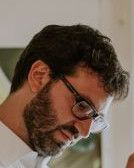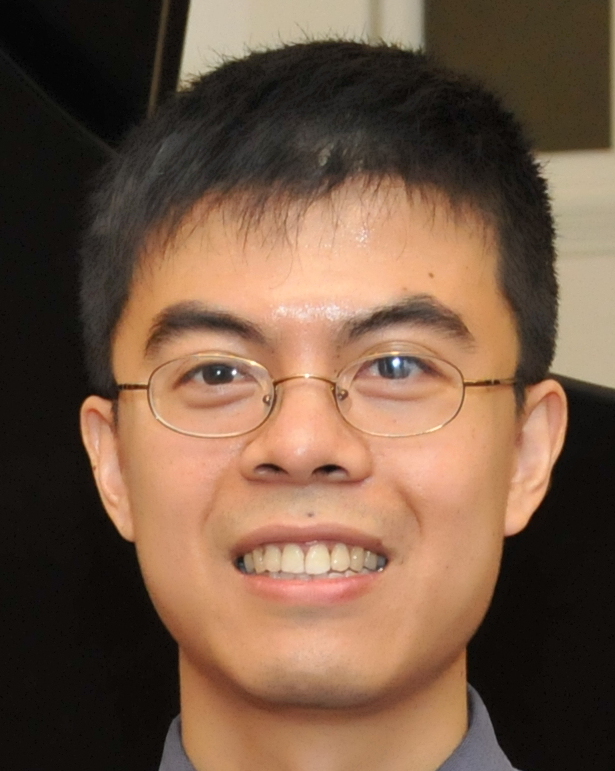|
|
13:45 -
13:50
Workshop introduction
|
 |
|
13:50 -
14:10
Chris Miall, University
of Birmingham
Sensorimotor delays,
synchronisation and prediction
Abstract
I will summarise
human and non-human
primate data that highlight the constraints that sensory delays impose
on visually guided movements. This leads to theories of predictive
control, and the suggestion that forward models underpin much of our
behaviour, including coordination and synchronisation. I will end with
a summary of evidence that supports our hypothesis that the cerebellum
operates as a forward model, anticipating the sensory consequences of
actions.
|
 |
|
14:10 -
14:30
Marco Capogrosso,
Université de Fribourg
Design of
neuroprosthetic technologies for the restoration of brain-spinal
communication after spinal cord injury
Abstract
Severe Spinal Cord
Injury (SCI) alters
the communication between supra-spinal centers and the sensorimotor
networks coordinating limb movements, which are usually located below
the injury. Epidural electrical stimulation of lumbar segments has
shown the ability to enable descending motor control of the lower limbs
in rodents and humans with severe paralysis. Using computational models
and in vivo experiments in rodents, we found that EES facilitates motor
control through the recruitment of muscle spindle feedback circuits.
This enables the synchronization and integration of sensory feedbacks
and residual motor commands to produce synergistic and coordinated
movement. This framework supported the design of brain controlled
stimulation strategies that restored locomotion in primates after
spinal cord injury, holding promises for applications in humans.
|
 |
|
14:30 -
14:50
Vincent Cheung, The
Chinese University of Hong Kong
Synergies for muscle
synchronization as post-stroke recovery biomarkers
Abstract
For any motor act,
the central nervous
system (CNS) must assemble a coordinated pattern of muscle activities
both to achieve the intended motion, and to stabilize the joints whose
motions are undesired. The computations behind this assembly are
extraordinarily complicated, in that the hundreds of muscles spanning
the hundreds of joints constitute a large search space of motor
commands even for an apparently simple movement. At least for motor
activities of daily living, the CNS may circumvent this complexity by
generating muscle commands through the combination of a manageable
number of pre-specified units, each of whose activation would
simultaneously recruit a specific group of muscles. These units,
variously called motor primitives, neuromotor modules, or muscle
synergies, are in essence a set of neurophysiological mechanisms for
synchronizing motoneuronal activities for purposeful motor behaviors.
Recent rodent optogenetic experiments of ourselves and others have
argued that muscle synergies are encoded by spinal excitatory
interneurons that are modulated by both proprioceptive and
corticospinal drives. A similar organization may also exist in humans,
as indicated by our recent data obtained from human subjects during
lower-limb adaptation tasks. Kinematic and EMG recordings from stroke
survivors further suggest that specific muscle synergies may serve as
stroke recovery biomarkers, and thus could be natural targets of
intervention for stroke-rehab assistive technologies.
|
 |
|
14:50 -
15:10
Massimo Sartori, University
of Twente
Neuro-Mechanical
Interfacing for Neuro-Rehabilitation Technologies
Abstract
The development of
personalized neurorehabilitation and augmentation technologies requires
the profound understanding of the neuro-mechanical processes underlying
an individual's motor function, impairment, and recovery. A
major challenge is the difficulty of accessing the in vivo neural
activity underlying human movement concurrently with the resulting
mechanical forces elicited at the musculoskeletal level. Key factors
for addressing this challenge are the development of techniques for
interfacing with the human nervous system and for the accurate decoding
of the resulting motor function under neurophysiological control. In
this presentation I will discuss clinically viable methods for
accessing the neural information underlying an individual's
movement from electrophysiological recordings and the development of
subject-specific neuromusculoskeletal modeling formulations that can
translate neural inputs into the resulting mechanical output. I will
then outline how this paradigm enables establishing effective solutions
for replacing or restoring movement in impaired individuals and for
developing bio-inspired controllers for wearable technologies.
|
|
|
15:10 -
16:00
Break
|
 |
|
16:00 -
16:20
Eduardo Rocon, Spanish National
Research Council
Robotic-assisted
gait training rehabilitation strategies for pediatric population with
Cerebral Palsy
Abstract
Cerebral Palsy (CP)
could be defined as a disorder that appears in infancy and permanently
affect posture and body movement but does not worsen over time. CP is
often associated with sensory deficits, cognitive impairments,
communication and motor disabilities, behaviour issues, seizure
disorder, pain and secondary musculoskeletal problems. Traditionally,
robotic strategies have been focused on the Pe- ripheral Nervous System
(PNS) supporting patients to perform repetitive movements (a
‘‘Bottom-Up approach’’).
However, CP primarily affects brain structures, and thus suggests that
both PNS and Central Nervous System (CNS) should be integrated into a
physical and cognitive rehabilitation therapy. Current studies manifest
that such integration of the CNS into the human–robot loop
maximizes the therapeutic effects, especially in children. During this
talk I will present and discuss a robot-based training program for gait
rehabilitation of pediatric population with Cerebral Palsy. The
robotic-based therapies were implement in the CPWalker device and
recreates a situation as similar as possible to a real gait scenario,
encouraging the patients to control different movements associated with
gait: not only individual movements of lower limb joints but also the
synergy between them while maintaining a proper posture of upper body.
We hypothesize that this interaction between the human and the machine,
performed following an appropriate progression of the variables,
boosted the rehabilitation of our patients.
|
 |
|
16:20 -
16:40
Renaud Ronsse, Université
catholique de Louvain
Adaptive oscillators
with humans in the loop
Abstract
Adaptive oscillators
are mathematical systems that can be used to extract the main features
(like frequency and amplitude) of (quasi-)periodic inputs, while
learning these features in dynamic state variables. In this talk, we
will review our recent efforts in using adaptive oscillators
with humans in the loop. In particular, the dynamic-system-like
properties of adaptive oscillators were exploited for doing state
observation, state prediction, state differentiation, inverse dynamical
modelling, bandpass filtering, and bandstop filtering; each time whith
the objective to enhance specific movement features of (disabled)
humans.
|
 |
|
16:40 -
17:00
Heike Vallery, Delft
University of Technology
Synchronizing human-robot interactive walking
Abstract
Human gait is an intrinsically rhythmic
movement. Whenever external support is necessary to enable walking,
particularly for users with neurological impairments or amputations,
this may alter or disrupt natural gait dynamics. In order to preserve
or restore such dynamics, hardware and control choices of robotic
devices to support walking can either be explicitly tuned to
incorporate the desired rhythmicity, or they can be designed in such a
way that they favor the emergence of rhythmicity, without any explicit
encoding thereof. This talk will focus mainly on the latter strategy
and provide examples of several real-world implementations. An outlook
will be given on transfer to the inverse problem: Human instructors
teaching bipedal robots to walk via rhythmic physical interaction.
|
 |
|
17:00 -
17:20
David J. Reinkensmeyer, University
of California, Irvine
Robotic
synchronization during musical finger training after stroke: A Hebbian
Model
Abstract
In this talk, I will
discuss a recent study in which we compared the therapeutic
effects of high and low levels of robotic assistance during finger
training. Participants (n = 30) with a chronic stroke and moderate
hemiparesis actively moved their index and middle fingers to targets to
play a musical game similar to GuitarHero three hours/week for three
weeks. The FINGER exoskeleton robot provided assistance synchronized to
the music; half of the participants were randomized to receive high
assistance (causing 82% success at hitting targets), while the other
half received low assistance (55% success). High levels of synchronized
assistance boosted motivation, as well as secondary motor outcomes
(Fugl-Meyer and Lateral Pinch Strength) – particularly for
individuals with more severe finger motor deficits. Importantly,
individuals with impaired finger proprioception at baseline benefited
substantially less from the training. These results show that
synchronized robotic assistance can promote key psychological outcomes
known to modulate motor learning and retention. Further, the
therapeutic effectiveness of synchronized robotic assistance appears to
derive at least in part from proprioceptive stimulation, consistent
with a Hebbian plasticity model.
|
|
|
17:20 -
17:25
Concluding remarks
|







